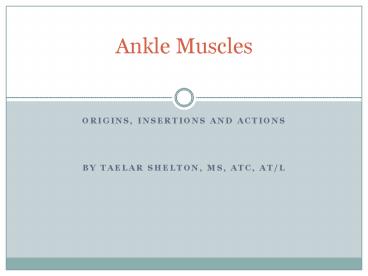ORIGINS, INSERTIONS AND ACTIONS - PowerPoint PPT Presentation
1 / 17
Title:
ORIGINS, INSERTIONS AND ACTIONS
Description:
Ankle Muscles ORIGINS, INSERTIONS ... bone A- prime mover of dorsiflexion inverts foot; assists in supporting medial longitudinal arch of foot Extensor Digitorum O ... – PowerPoint PPT presentation
Number of Views:76
Avg rating:3.0/5.0
Title: ORIGINS, INSERTIONS AND ACTIONS
1
Ankle Muscles
- ORIGINS, INSERTIONS AND ACTIONS
- BY TAELAR SHELTON, MS, ATC, AT/L
2
Origins of muscles
- Origins are the flixed attachment point of
muscles in the bone (this bone doesnt move when
the action of the muscle is performed)
3
Insertions of muslces
- Insertions is the attachment point of the tendon
into the bone that moves when the action of the
muscle is performed
4
Actions of muslces
- Actions- what the muscles does
5
Tibialis Anterior
- O- lateral condyle and upper 2/3rds of tibia
- I- by tendon into interior surface of medial
cuneiform and 1st metatarsal bone - A- prime mover of dorsiflexion inverts foot
assists in supporting medial longitudinal arch of
foot
6
Extensor Digitorum
- O- lateral condyle of the tibia proximal ¾ of
the fibula interosseous membrane - I- second and third phalanges of toes 2-5 via
extensor expansion - A- dorsiflexes foot prime mover of toe extension
7
Peroneus Brevis
- O- distal fibula shaft
- I- by tendon running behind lateral malleolus to
insert on the proximal end of the 5th metatarsal - A- plantar flexes and everts the foot
8
Extensor Hallucis Longus
- O- Anteriomedial fibula shaft and interosseous
membrane - I- tendon inserts on the distal phalnx of the
great toe - A- extension of the great toe dorsiflexion
9
Peroneus Tertius
- O- distal anterior surface of the fibula
interosseous membrane - I- Tendon passes anterior to lateral malleolus
and inserts on the dosum of the 5th metatarsal - A- dorsiflexes and everts the foot
10
Peroneus Longus
- O- head and upper portion of fibula
- I- by long tendon that curves under the foot to
1st metatarsal and medial cuneiform - A- plantarflexes and everts foot helps keep foot
flat on the ground
11
Tibialis Posterior
- O- extensive origin from superior tibia and
fibula and the interosseous membrane - I- tendon passes behind medial malleolus and
under the arch of the foot inserts into several
tarsals and metatarsals 2-4 - A- prime mover of foot inversion plantar flexes
ankle, stabilizes medial longitudinal arch
12
Flexor Digitorum
- O- Posterior tibia
- I- tendon runs behind medial malleolus and splits
to insert into distal phalanages of toes 2-5 - A- plantar flexes and inverts foot flexes toes
helps foot grip ground
13
Flexor Hallucis Longus
- O- middle part of the shaft of fibula
interosseous membrane - I- tendon runs under foot to distal phalanx of
great toe - A- plantar flexes and inverts foot flexes great
toe at all joints push off muscle during walking
14
Popliteus
- O- lateral condyle of femur
- I- proximal tibia
- A- flexes and rotates leg medially to unlock knee
from full extension when flexion begins
15
Plantaris
- O- posterior femur above the lateral condyle
- I- via a long, thin tendon into the calcaneus or
calcaneal tendon (achilles) - A- assists in knee flexion and plantar flexion of
foot
16
Soleus
- O- extensive cone shaped origin from the superior
tibia, fibula and interossous membrane - I- calcaneus via calcaneal tendon
- A- plantar flexes ankle important locomotor and
postural muscle during walking, running and
dancing
17
Gastrocnemius
- O- by two heads from the medial and lateral
condyles of the femur - I- calcaneus via calcaneal tendon
- A- Plantar flexes foot when knee is extended can
flex the knee when the foot is dorsiflexed































